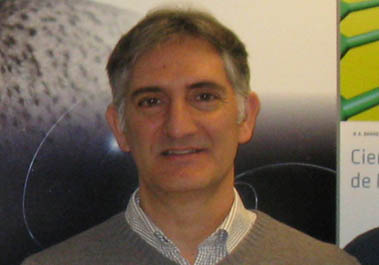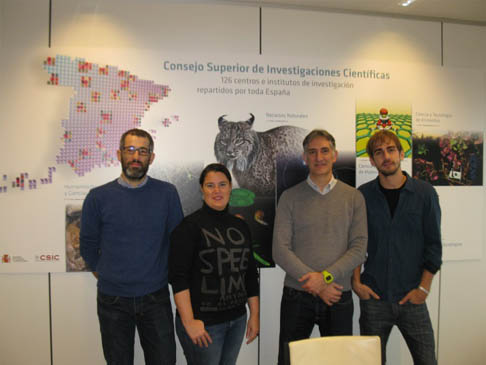
INTERVIEW WITH LUIS FONSECA CHÁCHARO
Luis Fonseca Chácharo, Doctor of Physics by the Autonomous University of Barcelona in 1992, developed his professional career in the National Centre of Microelectronics, where he was one of the deputy directors and currently leads the research group: “MicroEnergy sources and Sensor Integration”. He has participated in tens of national and international projects, and has published more than 70 articles. Furthermore, he is a member of the Directive Committee of the European Technology Platform on Smart Systems (EPoSS) and the Spanish Technological Platform TIC (PLANETIC), as well as a member of the Advisory Committee of the Central European Research Infrastructure Consortium (CERIC-ERIC).
What is the reason for and duration of your visit?
Making use of the facilities of the Office, I have called the committee of the NMBP project, which I coordinate, to hold a preparatory meeting for the Final Review that we will have tomorrow at the Covent Garden 2. It will be two days in Brussels; we´ll see which one is longer.
Is this an occasional visit or do you come to Brussels often?
I come here occasionally, not so much for matters regarding projects, but to attend events for the preparation and presentation of calls for the Framework Programme or JTIs (Joint Technology Initiatives). Regarding projects, we usually gather in the offices of the different partners; however, for the projects we are preparing we usually meet in Rue dû Trone at the proposal stage, and for those projects we have been granted, we prepare the “D day” here, like today.
Regarding the “SiNERGY” project (http://sinergy-project.eu), funded by the previous Framework Programme, what was the biggest achievement? Are you planning to continue with the same research line in another project?
“SiNERGY” was a choral and ambitious project that has developed microdevices of energy supply and storage, for which nanomaterials and micro-nanofabrication tools were used. Favouring the IMB-CNM, we have done so by using materials that are relative or compatible with silicon technologies, which, on the other hand, allow to manufacture, at low cost, the billions of devices of this kind that will be essential when the so-called “Internet of Things” arrives. Although we worked for three intense years, which was too short of a time for some developments, several interesting prototypes of thermoelectric microgenerators, mechanical energy harvesters (both electrostatic and piezoelectric) and solid-state and thin-layer batteries, which have been tested under realistic work conditions, were successfully developed.
I really want to continue with the same research line in another project, but this is very difficult in Europe. It is true that different teams of the project were granted regional, national or European funding to continue with some of their developments, but right now I don´t see that the conditions for a SiNERGY 2 are taking place.
Within this project, a patent pending for commercialisation was developed. Could you tell us if any support services have been used, such as the one offered by the European Commission (SSER) for the exploitation of results and what are the difficulties you have to face at this stage?
We did ask for a Seminar on Exploitation Strategy at the end of the first year, but I honestly didn´t know that this service expanded to the patent phase. I´m grateful for the link and I will do a search on what it can offer to finished projects in this regard.
After several years coordinating European projects, what lessons or good practices have you learned?
It hasn´t been many years. I´m a “soft” coordinator who resorts to the trust among partners and good humour. It works most of the time. However, I read all the reports of the project and I don´t approve them until they are well-structured and intelligible. I assure you that Officers and revisers appreciate this very much.
Lastly, what do you think about the future European Innovation Council? Do you think it is necessary?
I understand the interest in supporting disruptive innovation through start-ups and SMEs for the sake of the common economic and social good; however, it is not a matter of ideas (in Europe we don´t need ideas, nor organisations or alphabet soups…) but implementation and means.
What I would find interesting is that initiatives like EIC or SSER provided space for the systematic analysis of the results of the projects funded and offered finance automatisms (regional/national/European) that allow the promising results to continue in the road to innovation.
It is no secret that the concept of innovation has impregnated H2020; however, at the moment, this doesn´t seem to be yielding the results expected. I don´t know if the “math” has been done properly. Working with high TRLs (Technology Readiness levels) involves other expenses, other times and requires different skills. It doesn´t really seem that more money has been given to this… I have the feeling that in H2020 more resources have been given to innovation at the expense of R&D, with uncertain results. We are paying close attention to the eggs, but we are neglecting the chicken.
What I read from the drafts of the work programme for the last two years of H2020 doesn´t sound uplifting either. It seems that, in certain areas, much of the activity will be organised around competence centres and innovation hubs… in Spain, research is perro flaco (lean dog, poor) and we haven´t moved well in that direction either. I see I´m introducing many animals in this interview and I haven´t talked about bobcats, so I will finish by saying that we must keep fighting for the future like a belly-up lynx.

The team of the IMB-CNM in project Sinergy: “Silicon Friendly Materials and Device Solutions for Microenergy Applications”, funded by the 7th Framework Programme, at the central office of the CSIC in Brussels. To the left of coordinator Luis Fonseca, Gonzalo Murillo, participating researcher and one of the winners of “Innovators under 35, MIT Technology Review” in 2016. To his right: Gemma Martínez, who manages finances, and Carlos Calaza, another participating researcher.
